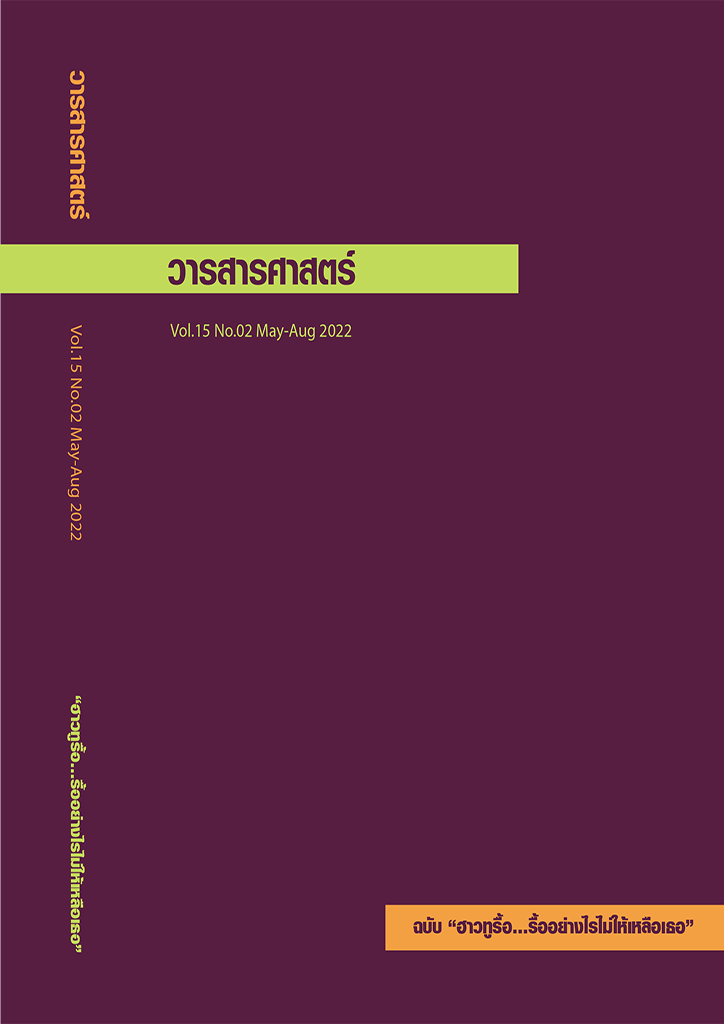แนวทางการวิจัยผู้รับสารเรื่องเสียงบรรยายภาพ
คำสำคัญ:
เสียงบรรยายภาพ, การวิจัยผู้รับสาร, การศึกษาผู้รับสารเรื่องเสียงบรรยายภาพบทคัดย่อ
ขณะที่เสียงบรรยายภาพในประเทศไทยกำลังพัฒนาขึ้นเรื่อยๆ นักวิชาการที่ทำงานด้านเสียงบรรยายภาพทั่วโลกก็เร่งพัฒนาองค์ความรู้เชิงวิชาการ เพื่อนำมาพัฒนาเสียงบรรยายภาพให้สอดคล้องกับความต้องการของผู้ใช้สื่อมากที่สุด ซึ่งหนทางที่จะนำไปสู่ผลลัพธ์นั้นคือ การวิจัยผู้รับสาร
อย่างไรก็ดี การวิจัยผู้รับสารเรื่องเสียงบรรยายภาพในประเทศไทยยังมีน้อย บทความชิ้นนี้จึงต้องการสำรวจแนวทางการวิจัยผู้รับสารเกี่ยวกับเสียงบรรยายภาพ เพื่อหาช่องว่างขององค์ความรู้ที่น่าจะศึกษาต่อไป โดยสำรวจรูปแบบการวิจัย ประเด็นที่ศึกษา กลุ่มตัวอย่าง รายการ และเครื่องมือที่ใช้ในการวิจัย ใช้วิธีวิเคราะห์เชิงเปรียบเทียบ (constant comparison analysis) จากงานวิจัย 13 ชิ้น ทั้งของไทยและต่างประเทศ
จากการศึกษาพบว่า แนวทางในการวิจัยผู้รับสารเรื่องเสียงบรรยายภาพมี 2 แนวทาง คือ แนวทางแบบดั้งเดิม และแนวทางแบบสร้างสรรค์ ซึ่งบูรณาการศาสตร์อื่นๆ เช่น วิทยาการคอมพิวเตอร์ วิทยาศาสตร์สุขภาพ เข้ามาประยุกต์ใช้ โดยผสมผสานกับการออกแบบการวิจัยผู้รับสารในแนวทางดั้งเดิม
เอกสารอ้างอิง
กุลนารี เสือโรจน์ (2558), การวิจัยถอดบทเรียนหลักการเขียนบทเสียงบรรยายภาพรายการอาหารทางโทรทัศน์เพื่อคนพิการทางการเห็น, กรุงเทพฯ: คณะวารสารศาสตร์และสื่อสารมวลชน มหาวิทยาลัยธรรมศาสตร์.
________. (2563) “แนวคิดการศึกษาเสียงบรรยายภาพสำหรับสื่อโทรทัศน์”, วารสารศาสตร์, 13(3): 188-188.
กุลนารี เสือโรจน์ และมนต์ศักดิ์ ชัยวีระเดช (2558), รายงานผลการเก็บข้อมูลจากการสนทนากลุ่มตัวแทนผู้พิการทางการเห็นในรายการโทรทัศน์ที่มีสื่อเสียงบรรยายภาพ (Audio Description), โครงการผลิตสื่อเสียงบรรยายภาพเพื่อการเข้าถึงกลุ่มคนพิการทางการเห็น คณะวารสารศาสตร์และสื่อสารมวลชน มหาวิทยาลัยธรรมศาสตร์.
ธีร์ธวัช เจนวัชรรักษ์ (2554), การสร้างออดิโอเดสคริปต์ชั่นในภาพยนตร์การ์ตูนเพื่อเด็กพิการทางการมองเห็น, วิทยานิพนธ์ปริญญานิเทศศาสตรมหาบัณฑิต จุฬาลงกรณ์มหาวิทยาลัย.
ธีร์ธวัช เจนวัชรรักษ์ และคณะ (2562), “สถานการณ์ปัจจุบันของเสียงบรรยายภาพ สำหรับรายการโทรทัศน์ในประเทศไทย”, มนุษยศาสตร์วิชาการ, 26(1): 286-314.
ภัทธีรา สารากรบริรักษ์ (2558), เสียงบรรยายภาพที่ผู้พิการทางการเห็นต้องการ, กรุงเทพฯ: คณะวารสารศาสตร์และสื่อสารมวลชน มหาวิทยาลัยธรรมศาสตร์.
________. (2559), “เสียงบรรยายภาพที่คนพิการทางการเห็นต้องการ”, วารสารศาสตร์, 9(2): 168-168.
อารดา ครุจิต (2558), การศึกษาหลักการในการผลิตเสียงบรรยายภาพในรายการโทรทัศน์สำหรับคนพิการทางการเห็น, กรุงเทพฯ: คณะวารสารศาสตร์และสื่อสารมวลชน มหาวิทยาลัยธรรมศาสตร์.
Braun, S. (2008), “Audio Description Research: State of the Art and Beyond”, Translation Studies in the New Millennium, 6: 14-30.
Caro, M. (2015), “The Emotional Experience of Films: Does Audio Description Make a Difference?”, The Translator, 21(1): 68-94.
________. (2016), “Testing Audio Narration: The Emotional Impact of Language in Audio Description”, Perspectives, 24(4): 606-634.
Chmiel, A. and Mazur, I. (2016), “Researching Preferences of Audio Description Users--Limitations and Solutions”, Across Languages and Cultures, 17(2): 271-288.
Di Giovanni, E. (2014), “Visual and Narrative Priorities of the Blind and Non-Blind: Eye Tracking and Audio Description”, Perspectives, 22(1): 136-153.
Fernández-Torné, A. and Matamala, A. (2015), “Text-to-Speech vs. Human Voiced Audio Descriptions: A Reception Study in Films Dubbed into Catalan”, The Journal of Specialised Translation, 24: 61-88.
Fernández, E. et al. (2015), “Cross-Fertilization between Reception Studies in Audio Description and Interpreting Quality Assessment: The Role of the Describer’s Voice”, in Audiovisual Translation in a Global Context, London: Palgrave Macmillan.
Hättich, A. and Schweizer, M. (2020), “I Hear What You See: Effects of Audio Description Used in a Cinema on Immersion and Enjoyment in Blind and Visually Impaired People”, British Journal of Visual Impairment, 38(3): 284-298.
Holsanova, J. (2016), “A Cognitive Approach to Audio Description”, in Researching Audio Description, London: Palgrave Macmillan.
Lopez, M. et al. (2018), “Audio Description in the UK: What Works, What Doesn’t, and Understanding the Need for Personalising Access”, British Journal of Visual Impairment,36(3): 274-291.
Morley, D. and Brunsdon, C. (1999), The Nationwide Television Studies, London: Routledge.
Onwuegbuzie, A. et al. (2012), “Qualitative Analysis Techniques for the Review of the Literature”, Qualitative Report, 17: 56.
Naraine, M. et al. (2018), “Impacts on Quality: Enjoyment Factors in Blind and Low Vision Audience Entertainment Ratings: A Qualitative Study”, PloS one, 13(12).
Pettitt, B. et al. (1996), “AUDETEL: Enhancing Television for Visually Impaired People”, British Journal of Visual Impairment, 14(2): 48-52.
Piper, M. (1988), “Audio Description: Pioneers Progress”, British Journal of Visual Impairment, 6(2): 75-6.
Ravindran, V. (2019), “Data Analysis in Qualitative Research”, Indian Journal of Continuing Nursing Education, 20(1): 40.
Remael, A. et al. (2015), Pictures Painted in Words: ADLAB Audio Description Guidelines, EUT: Edizioni Università di Trieste.
Snyder, J. (2014), The Visual Made Verbal, Arlington: The American Council of the Blind.
Walczak, A. and Fryer, L. (2017), “Creative Description: The Impact of Audio Description Style on Presence in Visually Impaired Audiences”, British Journal of Visual Impairment, 35(1): 6-17.
________. (2018), “Vocal Delivery of Audio Description by Genre: Measuring Users’ Presence”, Perspectives, 26(1): 69-83.
Audio Description Coalition (2009), Standards for Audio Description and Code of Professional Conduct for Describers, retrieved 15 January 2020 from http://audiodescriptioncoalition.org/standards.html.
Chmiel, A. and Mazur, I. (2012), AD Reception Research: Some Methodological Considerations, retrieved 15 January 2020 from
Clark, J. (2007), Standard Techniques in Audio Description, retrieved 15 January 2020 from http://joeclark.org/access/description/ad-principles.html.
Hall, S. (1973), “The ‘Structured Communication’ of Events”, retrieved 15 January 2020 from http://epapers.bham.ac.uk/2960/1/Hall_SOP05_1973.pdf
Independent Television Commission (2000), ITC Guidance on Standards for Audio Description, retrieved 15 January 2020 from http://audiodescription.co.uk/uploads/general/itcguide_sds_audio_desc_word3.pdf
The American Council of the Blind (2010), Audio Description Guidelines and Best Practices in Audio Description Project, retrieved 15 January 2020 from http://acb.org/adp/docs/AD-ACB-ADP%20Guidelines%203.1.doc.
UNITED NATIONS (2019), World Population Prospects 2019, retrieved 15 January 2020 from https://population.un.org/wpp/Download/.








